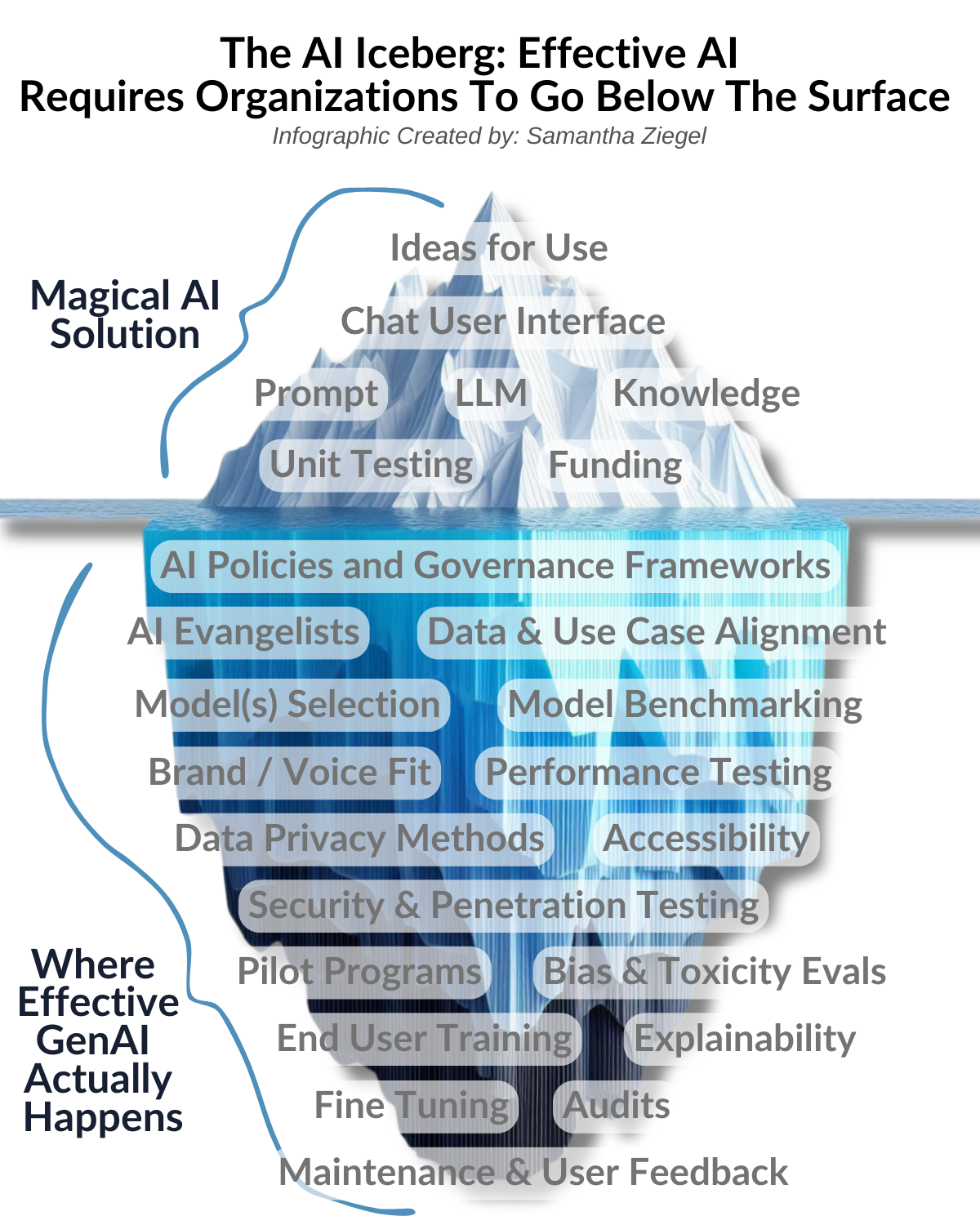Effective AI Solutions Start with a Comprehensive Strategy
In the realm of generative artificial intelligence, the allure of “magical AI solutions” captures the attention of executives. However, as this infographic aptly illustrates, the visible success of AI is just the tip of the iceberg. Beneath the surface lies a comprehensive strategy that supports and sustains these solutions. Building and deploying effective AI solutions requires a multi-faceted approach.
The Visible Iceberg: Creating Magical AI Solutions That ‘Work’
The tip of the iceberg represents the AI solutions that deliver entry-level results. These are the applications and systems that are easy to spin up and get excited about. Teams have high hopes for these simple solutions to drive immense business innovation and efficiency. However, long-lasting, reliable results often fade fast. These components alone do not ensure that the solution is accurate, trusted by end-users, and has the ability to scale when models change, new regulations are created, or adjust to new data trends from customers. Businesses need to look below the surface and implement a lasting strategy that empowers responsible, effective AI innovation.
The Foundational Depths: Strategic AI Elements Which Enable Effective AI
- AI Policies and Governance: Innovation is enabled through a strong culture which is empowered by understandable, relatable policies and risk frameworks. Organizations that successfully empower responsible AI innovation start with policy and mindset. This needs to be a top-down endeavor starting with stakeholder alignment.
- Data & Use Case Alignment: Crafting effective prompts for AI models and coming up with ideas for issues that AI can tackle is fun. On the other hand, is is an empty effort if the data is not 1) available, 2) quality, 3) in the right volume needed to support the use case, and 4) in the correct format for AI to pull insights from. The data needs to be driven by the use case. The use case needs to be measurable and stem from a proven business need.
- Testing: Testing AI solutions requires a multifaceted approach. Red teaming alone will not ensure the results match the business use case. Benchmarking needs to be driven from user behaviors and expected results. Test plans need to be maintained as data and models evolve overtime, supporting explainability and transparency. The responsibility of testing AI solutions falls on everyone.
- Security, Privacy, and Ethics: Robust security measures, ensuring data privacy, and making AI solutions are ethical are non-negotiable aspects of a comprehensive AI strategy. Organizations should partner with their data security, legal, compliance, and ethics leaders to ensure the overall approach to building scalable solutions match an organization-wide standard. As regulations and controls continue to evolve in the AI space, having a dedicated team focused on communications and considerations will reduce unwanted risk.
- Pilot Programs and Training: Pilot programs and providing end-user training help to ensure a scaled rollout plan. Not all AI solutions should be released to a large volume of users. Structure pilot programs can prove to be incredibly valuable if structured appropriately. Training for building and interacting with generative AI tools should be an ongoing, evolving effort at the organizational level.
- Maintenance and Audits: Continuous maintenance and regular audits are necessary to keep the AI solutions safe and up-to-date. Data needs from businesses and customers will evolve over time. New products will emerge. New knowledge bases will need to be created. Regular audits of usage, prompts, and end-user feedback will ensure the solution continues to be used in an ethical manner and continues to add value.
For executives, understanding that effective AI solutions are built on a deep, strategic, and broad foundation is crucial. By investing in these strategic elements, organizations can unlock the true potential of AI, enabling and driving responsible innovation and maintaining a competitive edge in the market. The iceberg metaphor serves as a reminder that while the initial solutions may seem magical, long-term solutions are supported by a well-planned and executed strategy.



This post brilliantly highlights that effective AI solutions require more than just surface-level implementation—success depends on a deep, strategic foundation that includes governance, data alignment, testing, security, and continuous maintenance. The iceberg analogy perfectly captures the need for a comprehensive approach to truly unlock AI’s potential.
Great insights on how effective AI solutions begin with a solid strategy! It’s fascinating to see how a well-thought-out approach can drive impactful results. At Viacon, we also emphasize the importance of a comprehensive strategy in our AI-powered digital marketing services, which help businesses leverage AI to optimize their marketing efforts and achieve their goals more efficiently. Looking forward to seeing more discussions on this topic